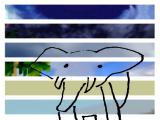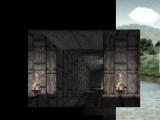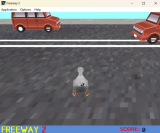experiment
100 Free Beetles
Thu, 04/06/2017 - 22:23 — mkapolk
WASD: move
mouse: look
scroll: zoom
Space: Jump
n: next scene
p: previous scene
A mashup of 100 Free Assets by Blueberrysoft and Noisy Beetle by clyde.
I really enjoyed reading about the process of Noisy Beetle, that of making a series of
very deliberate and thoughtful formal experiments to see how the different
elements of the game interact with each other to form a whole. I went to school
for digital media art, but where I felt like the classes for more traditional
forms of media had exercises that let you practice these formal interactions
really closely, the program I was in didn't really have that level of rigor and
experience when it came to game development.
The unity asset store is a treasure trove, and I feel a particular
materialistic allure from the funny meeting of the val-u-store marketing and
toylike nature of individual assets on the asset store (Fantasy SFX Sample Pak
w/ 10 FREE WEAPONS). Importing and playing with free assets is fundamentally
satisfying, but if you arrange and select your assets in the way they want to
be arranged, you end up with a game that's, at best, as milquetoast as the
individual assets. 100 Free Assets felt like a very good experiment in
reappropriating and recontextualizing those assets in a way that resolved* them
somewhat. So I wanted to try doing that, but with more of a compartmental,
Noisy Beetle kind of way.
The scenes are presented in the order they were made. I think there's a sense
of progression among them. The car and mushroom skeleton, particularly, feel
clean and purposeful and intentional, although with the skeleton particularly
it feels like I found a few asset packs that fit together tonally and
thematically and made a scene with them, rather than working towards a more complete
resolution to the problem of assets, in general. But the idea of climbing on a big skeleton overgrown with mushrooms
was too delightful, and when I found that wonderful space within his ribs,
well, I couldn't resist. I'm not sorry, but I do think there's a lot more work to be done before I feel really comfortable using assets.
* By resolved, I'm referring to the process of removing the various tensions that one feels from these assets:
On a formal level, they have the quality of images cut out of a magazine: a skeleton with an attack animation
wants to have something to attack, a photorealistic rock wants to nestle alongside a HD river with bloom lighting.
There's a context that gets conspicuously cut when the assets live on their own.
And this also gives the assets a certain awkwardness, since they often
aren't created to live in any world in particular, or they're made with reference to some kind of amalgam of random artistic styles
the artist wanted to mimic, but they don't land in any in particular.
There's also a political dimension to this tension, since the ostensible
purpose of the asset store is to serve up *professional* assets. Assets that
look as if a professional made them, and they belong in a AAA game. The deal being, if you
use these assets your game can look like it's a professional game too. And
the games that are born out of this faustian bargain - you know the type, with
a 10,000 poly Dark Knight stomping around an empty field with cartoon goblins -
reveal, by turns, the optimistic dreams of some kid who Wants To Make Games
When He Grows Up, or the cynicism of someone taking a pre-built infinite runner
and hacking in a different player model, or the narcissism of a
3-idea-guy-and-one-programmer team's kickstarter ($10 pledged of $500,000)
who've got the next big MMORPG in the making. So this particular aesthetic
becomes a synecdoche for the whole fucked up relationship between individual gamers and
the multi billion dollar video game industry, with all the implications that that conjures up.
So, I know of two strategies to resolve this tension. The first is to simply
find the right assets that go together, polish up the gameplay, and make a
convincing fantasy that can hide the political dimensions of the relationship
between the game maker, the asset store, and the games industry. The other is
the strategy of the collage artist: to combine the elements in such a way that
their original purpose is subverted or obliterated. And there's a lot of ways
of achieving that: through punning recontextualization of the images, or
intentionally ruining the high quality assets, or using the objects such that
they're reduced to their formal qualities, or using the objects in such a way
that you create an aesthetic of ugliness, or whatever. 100 Free Assets makes
some good moves in that direction, THE ARCHICTECTURAL BODY AUTOMOBILISATION KIT
is another good one, and oikospiel looks promising, though I haven't played it
yet, but I think for the true masters you have to look back to Hannah Hoch or
Rauschenberg, and go from there.
ADVENTURES WITH CONSTRUCT 2 GOTY EDITION
Wed, 01/30/2013 - 17:06 — Smedis2Grumper: Better Movement Edition
Sun, 06/24/2012 - 16:16 — Danni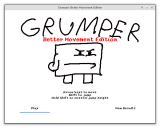
An attempt to correct what went horribly wrong with Grumper.
Main changes:
- Movement physics have been revamped to now have near-instant acceleration and deceleration both on land and in the air (though it's _slightly_ lower in the air still), as well as decrease max horizontal speed.
- Levels were tweaked a bit to accommodate the physics changes.
- The removal of selectable difficulty. This caused the experiment to break because everyone selected a different difficulty.
- A fix for the death location decals not actually getting limited to 100 on-screen.
- When you quit the game during a level, it still saves your death locations for that level.
Again, attach your stats-xx.txt file here when you're done playing.
Grumper
Wed, 06/20/2012 - 19:54 — Danni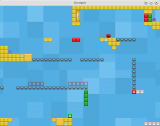
Move with the Arrow Keys. Jump using Shift. Hold Jump to vary your jump height.
More info:
Grumper is a Jumper clone I decided to make after playing the newly fixed Linux version of Super Meat Boy for a while and then reminiscing about the classic Jumper games by YoMamasMama, and then wanting to design a Jumper-esque game of my own. I also made it because a while back, Sergio suggested I try experimenting with game difficulty by deliberately making the game easier or harder to play.
The game itself is quite like Jumper, although it uses Super Meat Boy-style deceleration (insta-brake while on land).
Unlike Jumper or Super Meat Boy, however, you can't double-jump or wall-jump.
- You want to get to the rapidly spinning portal on the other end of the level.
- Leaving the screen from ANY side will kill you, as will colliding with a spike ball. When you die, you reconstitute at the beginning of the level and any moving gimmicks will reset.
- The up-arrow blocks bounce you high (sixteen blocks high I believe). Normally you can only jump four blocks high. When you hit these blocks from the sides or from below, they act like a normal wall (that is, they don't bounce you).
- Red, green, blue blocks are toggle walls, which can be turned on or off by tapping the same color power switch.
- Moving platforms travel horizontally in one direction until they hit an obstruction, causing them to reverse.
The game is broken up into three difficulties: Easy, Normal, and Hard.
- Normal is the original set of 15 levels I created. The set starts off pretty basic with the first few levels, but gets pretty challenging near the end. Perhaps the difficulty curve is rather steep, but with only a small set of levels there isn't much I can do about that. Intended for most players (hopefully).
- Easy takes the Normal levels and makes most of the jumps shorter/easier, adds guard rails in some places (to prevent you from flying off the screen too easily), increases the coverage area of spring blocks, etc.
- Hard takes the Normal levels and increases the coverage area of spikes, shrinks a lot of platforms, and sometimes even forces you to complete a level in a roundabout way. Expect some rather tricky jumps. For veteran players only.
STATISTICS:
As you complete each level, the game saves statistics into a file on your hard drive. After you finish playing, look for a file in the game's folder titled "stats-16986802.txt" or something similar (the game will tell you exactly what the file is called). You can then select View Results from the main menu, choose this file from the selection dialog, and be able to view all the places you died, and how many times you died on each level. It would be pretty cool if you could upload the statistics file here as a comment attachment. That way I could see where people are dying the most, and just how difficult my levels are. Granted, the statistics are rather basic. They only include death locations, which aren't incredibly meaningful as far as determining where players are having trouble, especially in the more open areas. I tried addressing this a bit by adding in some spikes where you would normally just fall to a lower level on a failed jump. Still, I'm curious about this (and I don't feel like improving on the system - I'm kinda fed up with MMF2 right now as it is).
Note: Even if you don't finish the game (you give up on a certain level and close the game), it will still spit out a statistics file, and you're welcome to submit that as well. It just won't include statistics for any unfinished levels.
Other remarks:
This really is Game Maker territory. Game Maker excels at tile-based multi-level games where the same elements are reused throughout each stage. MMF2 does not. In fact, MMF2 has really poor support for global objects. This forced me to stuff all 15 levels into a single frame rather than have them on separate frames in order for me to retain my sanity (otherwise I'd have to retroactively apply changes to EVERY SINGLE LEVEL ONE BY ONE every time I wanted to change something). And then I tried squeezing 45 levels into the same frame but MMF2 really choked on that. I was forced to use a separate frame for each difficulty, thus any changes I might make in the future (if I can even be bothered) are not going to be global across difficulties unless I manually apply the changes to all difficulties. Also MMF2 is slow. Really slow. I think if I were to make a similar game again, I would stay far away from MMF2 and use something like Game Maker 5.3 or hell, even C++/Python/some other established programming language with Allegro/SFML instead. Klik just isn't cut out for this.
The music comes from an old module song, "galactic" by dark halo.


